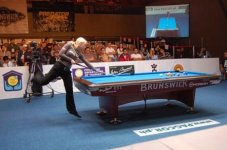Patrick Johnson said:I think it's a likely side effect of breaking as hard as possible. Maybe they don't know how to fix it. Maybe they think it's optimal for the same reason you do. Maybe you're right. I just don't think so.
Here's what I know:
It wastes power, something they're clearly trying to maximize.
The idea that it avoids collisions, especially that it avoids enough bad outcomes from collisions to matter more than the loss of power (and CB control), is highly speculative.
He scratched in one of those videos.
pj
chgo
The idea that someone is clearly trying to maximize power over positive results? well this thought really amuses me. Everything that Shane is trying to accomplish during the break to include getting whitey in the air, he does very well.
